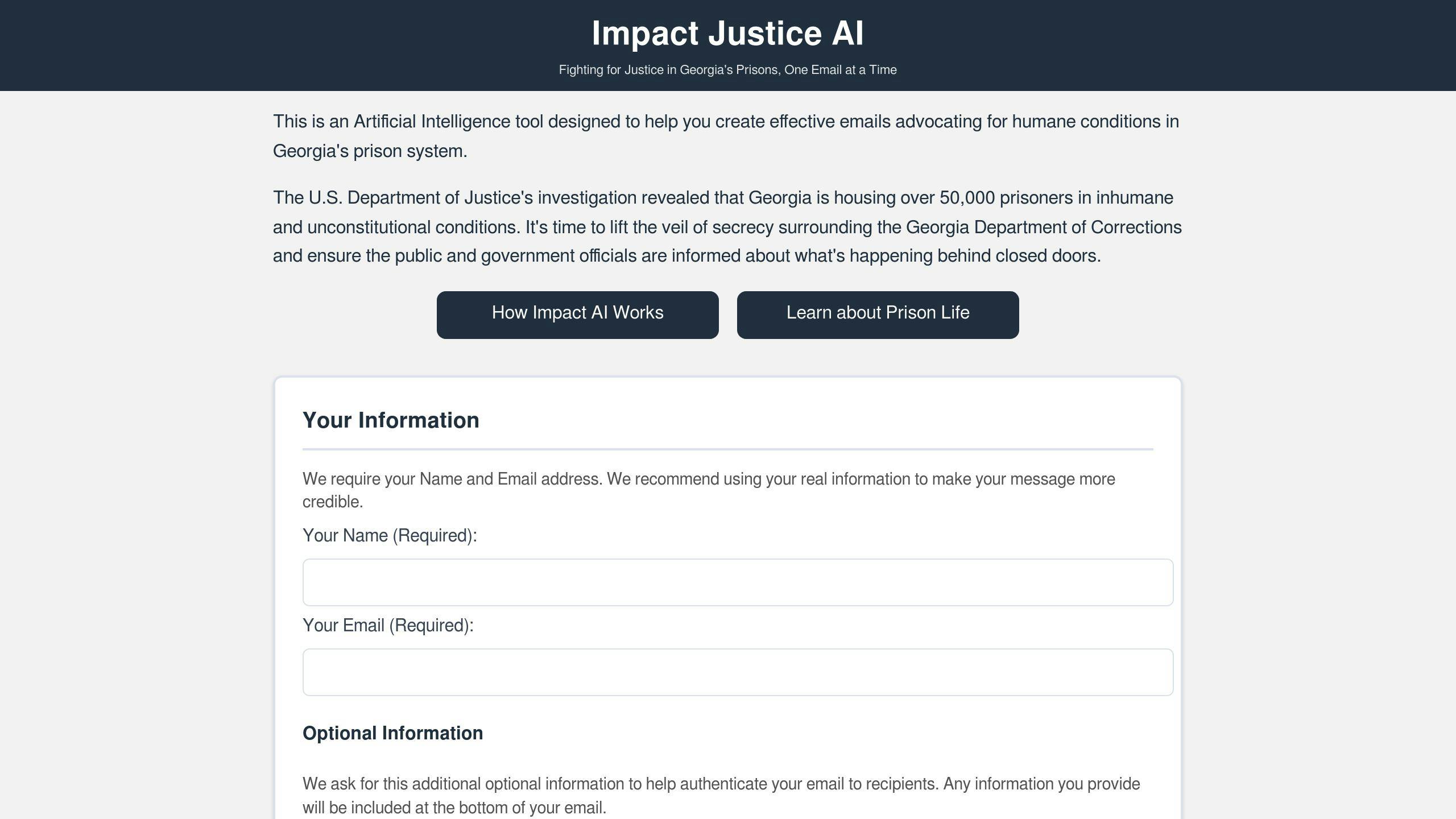Did you know that U.S. prisons are turning into nursing homes? The number of inmates aged 55+ has increased by 280% since 1999, with elderly prisoners costing five times more to house than younger inmates. Chronic illnesses, inaccessible facilities, and limited support after release make aging in prison a growing crisis.
Key Facts:
- Costs: $68,000/year per elderly inmate vs. $34,000 for younger inmates.
- Health Issues: 25% of elderly inmates have diabetes; 40-50% suffer from hypertension.
- Infrastructure Problems: Only 12% of prisons meet ADA standards; 38% of elderly inmates report fall-related injuries.
- Post-Release Challenges: 29% homelessness rate; 22% find jobs within a year.
Solutions:
- Early release programs for low-risk elderly inmates can save $40M annually.
- Investing in accessible prison infrastructure reduces safety risks.
- Advocacy tools like Impact Justice AI drive policy reforms to address these challenges.
This guide dives into the problems, costs, and policy changes needed to address the aging prison population crisis.
Main Problems for Older Inmates
Medical Care and Health Issues
Older inmates face serious healthcare challenges, with chronic conditions affecting them at much higher rates than the general population. For instance, 25% of older inmates have diabetes, compared to just 10% among the general public [2][3]. Hypertension is even more common, impacting 40-50% of older prisoners [2].
Prison healthcare systems often fall short in addressing these needs. Managing chronic conditions requires:
These gaps in care leave older inmates vulnerable, especially in environments ill-suited for their health issues.
Prison Building and Access Issues
Prison infrastructure is another major hurdle for elderly inmates. According to the Department of Justice, only 12% of state prisons comply with ADA standards [1][5]. This lack of accessibility creates significant safety risks:
| Problem | Impact on Elderly Inmates |
|---|---|
| Upper bunk assignments | 38% report fall-related injuries [4] |
| No wheelchair ramps | 68% rely on staff for basic mobility assistance [1] |
| Lack of handrails | 84% of multi-level facilities increase fall risks [5] |
| Distance to medical units | Inmates walk an average of 0.5 miles in state prisons [1] |
Temperature regulation is another critical issue. Most prisons lack proper heating and cooling systems, which disproportionately impacts older inmates who are more sensitive to extreme temperatures.
Life After Release for Older Ex-Inmates
Life outside prison doesn’t offer much relief for elderly ex-inmates. Many, originally incarcerated for non-violent offenses, face new challenges after release. Employment is a major obstacle – only 22% secure jobs within their first year post-release [4]. This is due to several factors:
Housing is another pressing issue. Around 18% of older ex-inmates need assisted living or nursing home care [1]. However, 63% are denied placement because of criminal records (42%), funding shortages (31%), or lack of available beds (27%) [4]. These barriers contribute to a staggering 29% homelessness rate among elderly releasees [1].
Mental health struggles further complicate reentry. Older ex-inmates experience dementia rates that are 53% higher than their peers in the general population [3].
Cost and Policy Effects
Cost of Housing Older Inmates
Caring for older inmates is expensive, mainly due to their extensive healthcare needs. Chronic illnesses and age-related conditions require constant attention, leading to costs that are 2-3 times higher than for younger inmates. In federal prisons, healthcare spending per older inmate is five times greater compared to their younger counterparts [2][3].
Current Laws and Their Effects
Mandatory minimum sentencing laws have significantly shifted the makeup of prison populations. Since 2003, life without parole sentences have risen by 68%, with almost 40% of these sentences involving individuals aged 55 and older [6].
Parole restrictions further compound the issue. As of 2024, 28 states prevent parole eligibility for certain violent crimes, regardless of the offender’s age or health [6]. This stands in contrast to data showing that older inmates have a much lower likelihood of reoffending.
Cost Savings Through Reform
These restrictive policies increase financial strain, but they also highlight opportunities for change. According to the Department of Justice Inspector General, transferring just 10% of elderly inmates to community care could save $40 million annually in federal prison systems [2].
Recidivism rates back up the case for reform. Inmates released at age 65 or older have a recidivism rate of only 4%, compared to the overall rate of 43% [1][3]. Even those released at 50 or older show a low rate of 7% [3].
These numbers indicate that introducing age-focused release programs could significantly cut costs without compromising public safety. For prisons with a high number of elderly inmates, such changes could ease the financial burden while addressing the unique needs of this population [2].
sbb-itb-25113a2
Taking Action for Change
Impact Justice AI: Digital Advocacy Support

Impact Justice AI helps streamline efforts to advocate for aging inmates by creating evidence-based messages on geriatric care and release programs. It pulls data from sources like DOJ reports and investigative findings. Campaigns using similar AI tools have shown a 62% higher response rate from legislators compared to traditional approaches.
These tools play a direct role in driving policy changes, such as early release programs, which have proven to offer both humanitarian and financial advantages.
Early Release Programs
New York’s Elder Parole Program, launched in 2018, successfully released 800 medically vulnerable inmates. This program maintained a low 4% recidivism rate and saved $240,000 annually per individual [8].
In Pennsylvania, a different approach includes partnerships with medical schools to provide specialized healthcare training for inmates [2][3].
Working with Reform Groups
The National Association of Area Agencies on Aging (n4a) has built strong partnerships to address the needs of elderly inmates [1]. Key collaborators include:
- Families Against Mandatory Minimums: Focused on legal advocacy for age-related sentencing reforms.
- Prisoner Reentry Institute: Specializes in job placement for elderly individuals post-incarceration.
- n4a: Works to improve access to healthcare for aging inmates.
Virginia’s risk assessment program highlights how data can guide decisions on elderly inmate releases. This program has achieved 94% accuracy in identifying suitable candidates for release [8]. These collaborative efforts demonstrate how data-driven tools and partnerships can strengthen legislative reforms and advocacy work.
Aging Inmates: The Continual ‘Graying’ of America’s Prisons
Conclusion: Steps Toward Better Prison Care
With over half of older prisoners (55%) dealing with multiple chronic conditions [9], many prisons remain unprepared to meet their needs. Addressing these gaps requires targeted reforms that balance care for individuals with budgetary concerns. Some programs have already shown how this can be done effectively:
- Improving Infrastructure
Oregon’s updated prison units led to a 30% drop in elderly inmate falls [1]. Facilities should focus on adding medical-equipped cells, accessibility features, and dementia care units – currently available in only 7% of prisons [9].
- Implementing Cost-Effective Programs
Thoughtfully designed reforms can enhance care without compromising public safety. Success depends on proper planning and oversight to ensure programs meet their goals.
- Learning from Advocacy Successes
The Osborne Association’s Elder Reentry Initiative in New York boasts an 85% success rate in securing housing for elderly inmates upon release. This shows how partnerships between corrections departments and community organizations can deliver real results.
For those looking to contribute to these efforts, here are some actionable steps:
- Use tools like Impact Justice AI to craft advocacy messages backed by data.
- Support groups like FAMM that focus on sentencing reform.
- Volunteer with local Area Agencies on Aging to assist with post-release support.
- Track progress through projections, such as the CDCR’s estimated 10.7% drop in elderly inmates by 2028 [7].
Programs like Virginia’s risk assessment initiative and Maryland’s medical parole enhancements highlight that meaningful change is possible. By combining proven models with advocacy tools and community efforts, there’s a clear path to improving prison care for aging populations.
